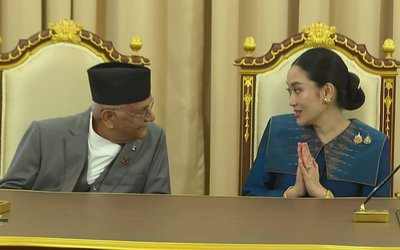Niraj Raj, a Nepali trader, was happy to sell the products he brought from Nepal to sell in 2nd China-South Asia Expo and 22nd Kunming Fair held last month in Kunming.
Not only Nepalis, Gulam Nasif, a trader from Bangladesh, was jubilant, too, as he was able to sell all his goods brought to Kunming. Along with the traders from Nepal and Bangladesh, the traders from India, Pakistan, Afghanistan, and Sri Lanka also had similar views.
As China’s middle class is growing, the demand of goods made in South Asia is growing there. It also opens new vistas for South Asian countries which remain closer with Kunming as a part of Silk Road.
“We found that China can be a good market for Indian handicraft as there is a high demand of Indian products,” said Atul Singh, a trader from New Delhi who had his stall in Kunming.
Although ravaged by war, traders from Afghanistan were also jubilant to see people coming to buy their goods. “We sold all our products within a few days,” Anbar Rehman said. “Next year, we will come with more products here as we now understand what the taste of China’s market is.”
Bordered with five South Asian countries, Afghanistan, India, Bhutan, Nepal and Pakistan, China is gradually moving to South Asia through reviving its ancient silk road.
As an observer of South Asian Association of Regional Cooperation (SAARC), China has been supporting South Asian countries as it has already contributed to South Asian Funds.
“China and South Asian countries have long relations. We share many things with South Asia including Buddhism and other cultures. This is the reason Kunming is giving high priority to South Asia,” said GAO Shuxun, vice governor of Yunnan Province.
As the vice governor said, South Asian countries are leading trade partners of China. India’s biggest trade partner is now China with over 70 billion dollar bilateral trade. Similarly, China is Nepal’s second largest trade partner. Bangladesh, Pakistan and Sri Lanka’s trade with China is growing.
Along with trading, China is also among the largest investors in Nepal, Sri Lanka, Pakistan, Bangladesh and the Maldives. Vice President of the Maldives recognized the investment made by China.
Bangladesh Prime Minister Sheikh Hashina said: “We are happy to say that China is the largest investor at this moment. We want to continue these relations. We want more investment in infrastructure from China for the prosperity of Bangladesh.”
Despite some political differences, India and China have seen their relations gain momentum. The establishment of BRICS bank is one of the significant moves in this region. As China’s economy grows, its neighbors feel the heat.
As South Asia is geographically attached with China, one cannot rule out the possibility that the relations of South Asian countries with China will further smoothen in the coming days.
If 2nd China-South Asia Expo and the 22nd Kunming fair are any indications, they show that South Asian countries will benefit a lot from linking their products with China’s customers. As China has allowed duty free markets for Nepalese products, it is likely to reduce the growing trade deficit.

Keshab Poudel
Poudel is the editor of New Spotlight Magazine.
- FM Dr. Deuba’s India Visit: Mission Aborted
- Mar 26, 2025
- AMBASSADOR MAEDA TORU: Warm Regards
- Mar 24, 2025
- PRO-MONARCHY MOVEMENT: Rising Dissatisfaction
- Mar 23, 2025
- Dr. PRABIN MANANDHAR: Person With Humility
- Mar 16, 2025
- US SUSPESION OF GRANT: Impact On Nepal
- Mar 10, 2025













